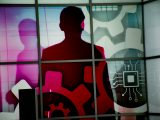
What happens when you cut living robots in half?
21. April 2020What happens when you cut living robots in half?
New York, 19.4.2020
A book is made of wood. But it’s not a tree. The dead cells have been reused for another purpose.
A team of scientists at the University of Vermont reused living cells – scraped from frog embryos – and assembled them into completely new life forms. These millimeter-wide „xenobots“ can move towards a target, perhaps pick up a payload (like a drug that needs to be transported to a specific location inside a patient) – and heal themselves after cutting.
„These are novel living machines,“ says Joshua Bongard, a computer scientist and robotics expert at the University of Vermont who co-directed the new research. „They are neither a traditional robot nor a known animal species. It’s a new class of artifacts: a living, programmable organism.“
The new creatures were designed on a supercomputer at the UVM – and then assembled and tested by biologists at Tufts University. „We can imagine many useful applications for these living robots that other machines can’t do,“ says co-director Michael Levin, who heads the Center for Regenerative and Developmental Biology at Tufts University, „such as searching for bad compounds or radioactive contamination, collecting microplastics in the oceans, traveling in arteries to scrape out plaque.
The results of the new research were published in the Proceedings of the National Academy of Sciences on 13 January.
Humans have manipulated organisms for the benefit of humans at least since the early days of agriculture, genetic manipulation is widespread, and a few artificial organisms have been assembled manually in recent years – by copying the body shapes of known animals.
But this is the first time ever that this research is designing „completely biological machines from scratch,“ the team writes in its new study.
After months of computation on the Deep Green supercomputer cluster at the UVM’s Vermont Advanced Computing Core, the team – including lead author and PhD student Sam Kriegman – used an evolutionary algorithm to create thousands of candidate designs for the new life forms. In an attempt to accomplish a task assigned by the scientists – such as moving in one direction – the computer repeatedly assembled several hundred simulated cells into countless shapes and body forms. While the programs ran – driven by basic rules about the biophysics of what a single frog skin and heart cells can do – the more successful simulated organisms were retained and refined, while failed designs were discarded. After a hundred independent runs of the algorithm, the most promising designs were selected for testing.
Then the Tufts team, led by Levin and with the key work of microsurgeon Douglas Blackiston, brought the in silico designs to life. First they collected stem cells obtained from the embryos of African frogs, the species Xenopus laevis. (Hence the name „Xenobots“.) These were separated into individual cells and left for incubation. The cells were then cut using tiny tweezers and an even tinier electrode, and under a microscope, the cells were joined together to form a close approximation of the patterns provided by the computer.
The cells were assembled into body shapes never before seen in nature and began to work together. The skin cells formed a more passive architecture, while the once random contractions of the heart muscle cells were used to create an orderly forward movement controlled by the computer’s design and supported by spontaneous self-organizing patterns that allowed the robots to move independently.
It has been shown that these reconfigurable organisms are able to move in a coherent manner and explore their aqueous environment for days or weeks, driven by embryonic energy stores. However, when they turned around, they failed, like beetles tilting on their backs.
Later tests showed that groups of Xenobots moved in a circle and pushed pellets to a central location – spontaneously and collectively. Others were built with a hole in the middle to reduce air resistance. In simulated versions of this, the scientists were able to reuse this hole as a bag to successfully carry an object. „This is a step towards the use of computer-designed organisms for the intelligent administration of drugs,“ says Bongard, a professor in the Department of Computer Science and Center for Complex Systems at the UVM.
Living Technologies
Many technologies are made of steel, concrete or plastic. This can make them strong or flexible. But they can also cause environmental and human health problems, such as the growing scourge of ocean pollution from plastics and the toxicity of many synthetic materials and electronics. „The downside of living tissue is that it is weak and degrades,“ says Bongard. „That’s why we use steel. But organisms have 4.5 billion years of experience in regenerating themselves, and that over decades. And when they stop working – dying – they usually fall apart harmlessly. „These xenobots are completely biodegradable,“ says Bongard, „and when they finish their work after seven days, they’re nothing but dead skin cells.
Their laptop is a powerful technology. But try to cut it in half. That doesn’t work so well. In the new experiments, the scientists cut the xenobots and observed what happened. „We almost cut the robot in half, and it sews itself back together and continues,“ says Bongard. „And that’s something you can’t do with typical machines.“
Cracking the code
Both Levin and Bongard say that the potential of what they have learned about the way cells communicate and connect reaches deep into computational science and our understanding of life. „The big question in biology is to understand the algorithms that determine form and function,“ Levin says. „The genome encodes proteins, but transformative applications are waiting for us to find out how this hardware enables cells to work together to create functional anatomies under very different conditions.
In order for an organism to develop and function, a lot of information needs to be exchanged and cooperated with – organic computing – not just within neurons, but constantly in and between cells. These emergent and geometric properties are formed by bioelectrical, biochemical and biomechanical processes „that run on DNA-specific hardware,“ says Levin, „and these processes are reconfigurable and enable novel forms of life to be created.
The scientists see the work presented in their new PNAS study – „A Scalable Pipeline for the Design of Reconfigurable Organisms“ – as a step towards the application of the findings on this bioelectric code in both biology and computer science. „What actually determines the anatomy with which cells work? asks Levin. „You look at the cells that we used to build our Xenobots, and genomically they are frogs. They are 100% frog DNA – but they are not frogs. Then you ask: „What else can these cells build?
„As we have shown, these frog cells can be persuaded to produce interesting life forms that are completely different from their standard anatomy,“ Levin says. He and the other scientists on the UVM and Tufts team – supported by DARPA’s „Machines for Lifelong Learning“ programme and the National Science Foundation – believe that building the xenobots is a small step towards cracking what he calls the „morphogenetic code“, which provides a deeper insight into the general way organisms are organised – and how they calculate and store information based on their history and environment.
Future Shocks
Many people are concerned about the effects of rapid technological change and complex biological manipulations. „This fear is not unreasonable,“ Levin says. „If we start messing around with complex systems that we don’t understand, we’re going to get unintended consequences.“ Many complex systems, such as a colony of ants, start with a simple unit – an ant – from which it would be impossible to predict the shape of their colony or how they could build bridges across the water with their interconnected bodies.
„If humanity is to survive in the future, we need to better understand how complex properties somehow arise from simple rules,“ Levin says. Much of the science is focused on „controlling the low-level rules. We also need to understand the high-level rules,“ he says. „If you wanted an anthill with two chimneys instead of one, how do you modify the ants? We wouldn’t have a clue.“
„I think it’s an absolute necessity for society to be better able to deal with systems where the outcome is very complex,“ Levin says. „A first step in that direction is to explore How do living systems decide what overall behavior should look like, and how do we manipulate the parts to get the behaviors we want?
In other words, „This study is a direct contribution to getting a grip on what people are afraid of, namely unintended consequences,“ says Levin – whether it’s the rapid arrival of self-propelled cars, the modification of gene drive to wipe out entire lines of viruses, or the many other complex and autonomous systems that will increasingly shape the human experience.
„There is all this innate creativity in life,“ says Josh Bongard of the UVM. „We want to understand it more deeply – and how we can channel and drive it into new forms“.


